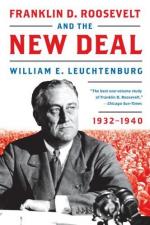
|
| Name: _________________________ | Period: ___________________ |
This test consists of 15 multiple choice questions and 5 short answer questions.
Multiple Choice Questions
1. Justice Louis Brandeis tells Roosevelt in 1935 that he must return to regulated competition, the "little unit." To which other president had Brandeis given this advice?
(a) Woodrow Wilson.
(b) Warren G. Harding.
(c) Calvin Coolidge.
(d) Herbert Hoover.
2. In which of the following cities does "Winter of Despair" say unpaid teachers faint in their classrooms due to lack of food?
(a) Detroit.
(b) Washington, D.C.
(c) New York City.
(d) Chicago.
3. In "Winter of Despair" a group of fifty-five men is charged with dismantling and carrying away a whole four-story building in which of the following cities?
(a) Detroit.
(b) Seattle.
(c) Des Moines.
(d) Chicago.
4. The quote from Harold Clurman at the beginning of "Winter of Despair" states that people could smell what in the air during the winter of 1932-33?
(a) Hope.
(b) Depression.
(c) Starvation.
(d) Sulfur.
5. According to the end of "The Politics of Hard Times," what is the final Electoral College tally by which Roosevelt defeats Hoover?
(a) 519-12.
(b) 354-177.
(c) 472-59.
(d) 282-249.
6. In January of 1934 the first of a few challengers for Roosevelt springs up. What is the name of the challenger who proposes the Old Age Revolving Pensions plan?
(a) Homer Martin.
(b) Milo Reno.
(c) Francis Townsend.
(d) Frank Walsh.
7. As Roosevelt's inauguration approaches, he increasingly favors the ideas of which major economist?
(a) Alfred Marshall.
(b) John Stuart Mill.
(c) Adam Smith.
(d) John Maynard Keynes.
8. According to "Winter of Despair," which of the following individuals works for The New York Times and first coins the phrase "brain trust" in reference to Roosevelt's advisers?
(a) James Kieran.
(b) Samuel Rosenman.
(c) Basil O'Connor.
(d) Raymond Moley.
9. During the Blue Eagle parade in New York City, Roosevelt remarks that there is a unity sweeping America that has not been seen since what year?
(a) 1917.
(b) 1914.
(c) 1901.
(d) 1922.
10. Pecora's investigation into the House of Morgan partners in May of 1933--and the subsequent income tax revelations--leads Congress to pass which of the following bills?
(a) Wagner Act.
(b) Glass-Steagall Act.
(c) Gold Reserve Act.
(d) Economy Act.
11. By the time Roosevelt is inaugurated, how many states have closed their banks?
(a) 23.
(b) 14.
(c) 38.
(d) 49.
12. Which of the following individuals switches California's votes to Roosevelt during the 1932 Democratic convention, thus making Roosevelt the Democratic candidate?
(a) William McAdoo.
(b) J. Hamilton Lewis.
(c) John Nance Garner.
(d) Melvin J. Traylor.
13. In which of the following cities does Roosevelt accept the Democratic nomination for President after the 1932 convention?
(a) Portland.
(b) Chicago.
(c) Brooklyn.
(d) St. Louis.
14. In which of the following cities does the American Federation of Labor hold its 1934 convention?
(a) Atlanta.
(b) Des Moines.
(c) San Francisco.
(d) New York.
15. The 1935 Banking Act aims to bring all large state banks under the jurisdiction of the Federal Reserve Board by requiring them to join the Federal Reserve System by what year?
(a) 1939.
(b) 1937.
(c) 1940.
(d) 1942.
Short Answer Questions
1. In the spring of 1932, in which state is Roosevelt Governor?
2. In the summer of 1932, farmers riot in all but which of the following states?
3. Leuchtenburg describes an incident where about 50 people fight over a barrel of garbage left at the back door of a restaurant. In which city does this take place?
4. In the spring of 1934, after the demise of the Civil Works Administration, the Federal Emergency Relief Administration helped how many students attend college?
5. Which of the following individuals commits suicide in March of 1932 and is proved a swindler of $100,000,000 in bonds a month after his death?
|
This section contains 545 words (approx. 2 pages at 300 words per page) |

|




